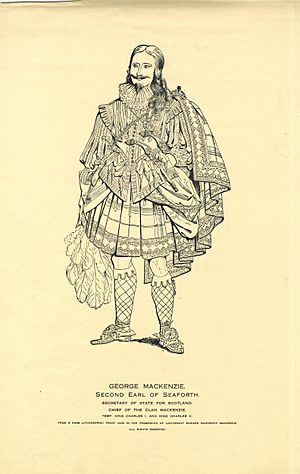George Mackenzie, 2nd Earl of Seaforth facts for kids
George Mackenzie, 2nd Earl of Seaforth (died 1651) was an important Scottish nobleman and a leader of a Highland clan. He was known as the 2nd Earl of Seaforth. He lived during a time of great change in Scotland, playing a shifting role in the Wars of the Three Kingdoms.
Contents
Who Was George Mackenzie?
George Mackenzie was the son of Kenneth Mackenzie, 1st Lord Mackenzie of Kintail. His mother was Isobel Ogilvie. The Mackenzies were a powerful clan from Ross-shire in the Scottish Highlands. They became very important in the 1400s.
George became the Earl of Seaforth in 1633. This happened after his older half-brother, Colin, passed away without any sons. Before becoming an Earl, George was known as George Mackenzie of Kildun.
Vast Lands and Estates
George Mackenzie inherited a huge amount of land from his family. His ancestors had worked hard to gain many properties.
By 1633, he owned many areas, including the lands around Ellandonnan and Lochalsh. These lands included towns like Lochcarron, Auchnaschelloch, and Attadill. He also had fishing rights in both salt and fresh water. His estates also covered Kisserin and Torridan, with the important Strome Castle.
He also inherited the lands of Pluscardine in 1620. Later, he gained more properties like Balmungie, Avoch, and Raasay.
Scotland's Civil War Role
During the Bishops War, George Mackenzie supported the Covenant. This was a group who wanted to protect the Scottish Church. He was made a general for the Covenanters north of the Spey River. However, he stopped fighting when the Pacification of Berwick peace treaty was signed in 1639.
When Montrose joined the King's side, people began to doubt Seaforth's loyalty to the Covenanters. He was even put in prison for a short time in 1640. In 1641, he made a secret agreement with Montrose and other Earls against the Covenanters.
However, Seaforth kept changing his mind. He refused the King's offer to be a chief judge. He then fought against Montrose after Montrose won a battle in Aberdeen in 1644.
In 1645, Montrose won a famous victory at Inverlochy. After this, Seaforth met Montrose and was held captive for a few days. He promised to support the King and never fight against him again. Yet, soon after, he joined the Covenanting general, Sir John Hurry.
Seaforth took part in the Battle of Auldearn on May 9, 1645. This battle was between Hurry's army and Montrose's army. Montrose won again, but the Mackenzies were not badly hurt. Some people even thought Seaforth might have secretly helped Montrose during the battle.
After this, Seaforth refused a new military role from the Covenanters. He was even removed from the Church. He then openly joined Montrose at the siege of Inverness in 1646.
Clan Activities
After Montrose left Scotland in 1646, money was collected from leading Royalists. Sixteen members of the Mackenzie clan were asked to provide large loans. This list shows how wealthy some of the clan leaders were at the time.
Seaforth was also busy with his own clan matters. He tried to take control of Assynt from the Macleod clan. In May 1646, he attacked the castle of Donald Ban Mor Macleod. It was said that his men took thousands of cows, horses, sheep, and goats. They also burned the homes of many families.
Later Years and Death
In 1648, Seaforth gathered 4,000 men from the Western Islands and Ross-shire. He led them south to help the King. But after a few small fights, they went home to harvest their crops.
Seaforth's loyalty to the King was often questioned. When King Charles I surrendered to the Scots, Seaforth made peace with the Covenanters. However, the Church was still angry with him. They demanded that he do a public penance in sackcloth in Edinburgh's High Church. The proud Earl agreed and went through this humbling ceremony. His Church punishment was then removed.
Despite this public shame, after King Charles I died, Seaforth changed sides again. He went to Holland in 1649 and joined Charles II. Charles II made him the Principal Secretary of State for Scotland. However, Seaforth never got to do this job.
Death and Family
When Seaforth heard about the King's forces losing badly at the Battle of Worcester, he became very sad. He died in August 1651 in Schiedam, Holland.
He had married Barbara, daughter of Lord Forbes. They had at least eight children. His heir was Kenneth, who became the 3rd Earl. His daughters also married into important families. Jean married the Earl of Mar, Margaret married Sir William Sinclair, and Barbara married Sir John Urquhart.
Line of Chiefs
| Preceded by Colin Mackenzie |
Chief of Clan Mackenzie 1633–1651 |
Succeeded by Kenneth Mackenzie |
| Peerage of Scotland | ||
|---|---|---|
| Preceded by Colin Mackenzie |
Earl of Seaforth 1633–1651 |
Succeeded by Kenneth Mackenzie |


